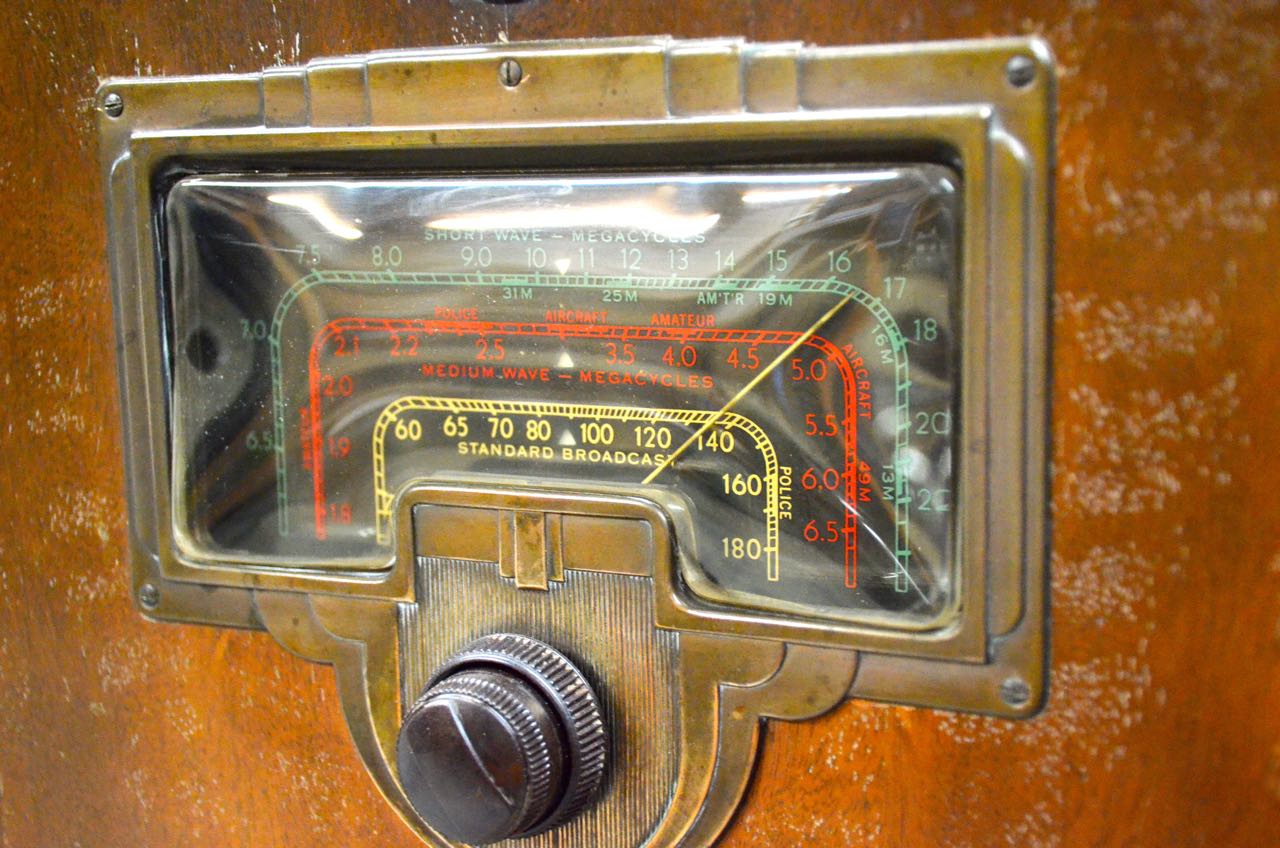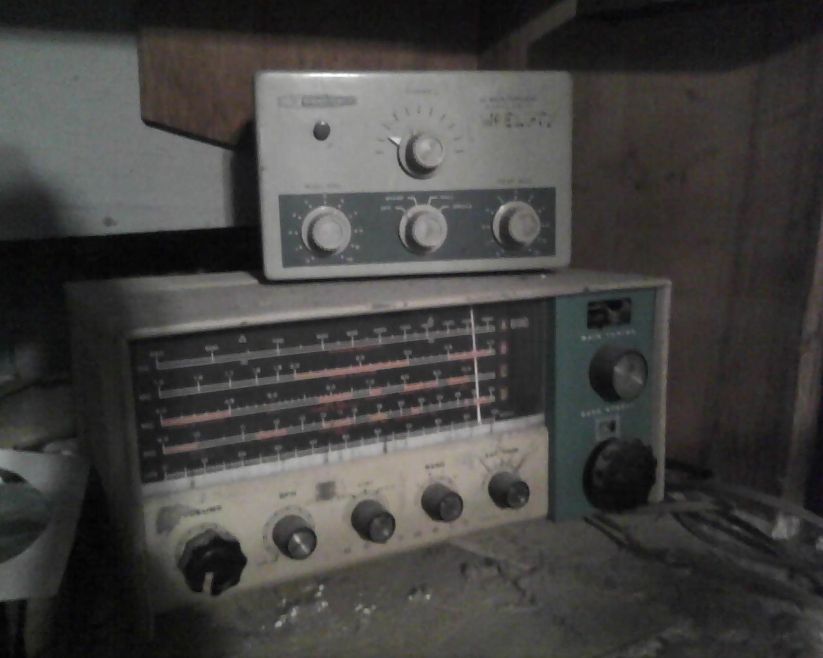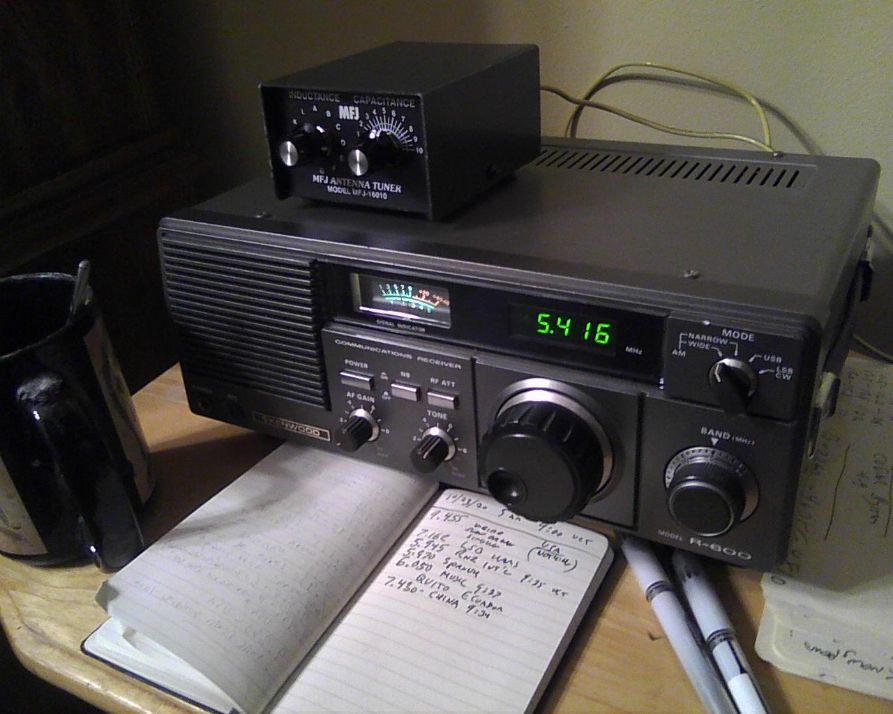 Many thanks to SWLing Post contributor, Jim Meirose, who recently shared the following listener post:
Many thanks to SWLing Post contributor, Jim Meirose, who recently shared the following listener post:
Listener Post by Jim Meirose
My interest in radio started around 1960-61. My uncle was going to take a giant worn-out console Record Player/AM/FM/SW 1940s monstrosity to the dump. My father, who was an electrician and a general nut for all things electrical, stopped him, took the radio out before the console got trashed, put it in a makeshift cabinet, and showed me how to use it. That was how I got started.
A neat thing about the radio was it had one of those old “magic eye” tubes to aid in tuning. What could be cooler for a kid to play with? Plus, being able to hear all of what was to me just “weird stuff” on shortwave, was what got me hooked.
After a year or two I got the Heathkit GR-91 as a gift and my father helped me assemble it. We also put up a better antenna.

My Heathkit GR-91 and Q-mult I used starting in 1963, with a variety of antennas, up to 1971. (Stored in the cellar now, as you can see)
I spent several years and many many hours listening and logging and having fun with it. We were at or near the peak of the sunspot cycle then, so as you can imagine, it was amazing. That made it a pretty “hot” radio (although in that decade the high sunspots made most every radio “hot”) but it had one flaw that was really bad. The tuning dial was not even close to accurate. I even had it professionally aligned, in vain. You only had a ballpark idea of what frequency you were on.
The next problem with the GR-91 was that as you tuned up past around 14 MHz, a hum began and grew to where there was no point trying to listen at all for anything all the way up to 30 MHz. I gradually became most interested in 20 meter amateur radio listening.
I learned to tune SSB, helped by the fact that the set had a good BFO and great bandspread tuning. From about 1964 to 1968, I heard hams from over 250 ARRL countries. These were mostly on 20 meters, using a dipole. Then, I got drafted to the Army until 1970, came back, and listened again until about 1972. Then, life took over, and the radio was put away.
Around 2004, I started getting interested again. I got an old Hammarlund HQ-180, thinking to pick up where I left off in ’72, but gave up when I found the sunspot cycle was bottomed out. Plus, the old set was too complicated and difficult to use, and not in the best shape. So, again, radio was put aside.
Finally, early this year, having the time at last to do things right, after shopping around, I got the Kenwood R-600, put up a good antenna, and started in. Once I got in the groove again, I found the R-600 to be incredible. The reception is crystal-clear across all bands. Plus, lo and behold, with the digital dial I know EXACTLY what frequency I am on! And as far as DX, even with today’s low sunspots, I am hearing the whole world, better than in the 60s. Might not be “booming in” as they say, but still very cool. The key is to know when, where, and how to listen.
Lastly, besides the better technology of the radio, imagine the difference between now and the ‘60s, when there was no internet, no computers, and practically no reliable hard copy directories to be found. At least with ham radio listening, it was easy to ID what country was on, because of the standardized call sign prefixes. But, for broadcast stations, the only real way to identify the more “exotic” non-english language stations, was by listening, sometimes for hours, hoping to catch some recognizable station ID. More often than not, this would never come before the station went off-air, or faded out. Today, with online directories, that is not such a problem. But, imagine how, with my GR-91, being unable to provide exact frequency readings, that even the modern online directories would have been practically useless.
That’s it, there are the highlights of my shortwave experience from 1960 to today. Hope it was of interest.
Thanks,
Jim Meirose
Thank you, Jim, for sharing your radio journey!
Jim’s radio story is the latest in our multi-year series called Listener Posts, where I place all of your personal radio histories. Feel free to submit your own by contacting me.


I recently bought an R-600 because my shack doesn’t have a general coverage receiver. It looks great next to my TS120s that I have had for 40 years. It’s a really good receiver and the sensitivity is very close to the TS120s, maybe 1 S-unit less. The only problem I have is that I need to remove the VFO knob to clean the old lubricant off of the vernier mechanism to fix the backlash issue. It probably has paint or something on the knurled knob to keep it from coming loose. The know won’t come off. Any ideas?
This shows you how to fix the backlash.
https://youtu.be/NB-d1WhD6qE
i bought an R600 new after college and still have it and it still works great. I have not had a problem with overloading even on a 70 ft longwire. thanks for the article.
Have had my R-600 since 2011. Bought it through eham classfieds. Starting in 1968 with Span Master, Star Roamer, DX-150A, Collins 75-a4, HQ-129x, DX-394, R-1000 and R-75. The R-600 is still here !
Thank you for sharing your early memories of SWLing and the excitement you got from a great sunspot cycle with an “OK” rig. It’s funny how simple things were back than (even without the internet) and the joy we got from it.
My early memories were as a novice (WN1SXH) and the Drake 2C and 2NT I had as my 1st station. I remember pulling in those faint CW calls at 2AM from the UK and pounding out my response. I’ll always remember those simple days. God bless SWL and Amateur Radio fans! Steve (K1KTF)
I also found this year an R-600 and an R-1000. But my preferred is the R-600, minimal, easy to use even at night, with a nice frontal loudspeaker! So fun to use!
I use my ham radio for SW listening besides ham stuff. I use a now old Icom756 Pro iii, a great rig in its time and does pretty good even now.
My major problem with SW now is American SW broadcasters are either far right wing (be sure to buy our year’s worth of food for the coming civil war) or ultra religious broadcasts and very little else coming out of US SW broadcasts.
Right now, the next solar cycle has officially started but still won’t peak for at least 5 years from now and overseas broadcasters are hard to hear because of weak signals.
So I have given up listening to SW, especially American SW. I am literally embarrassed when I think about people in other countries listening and I have to think they consider those stations to be some kind of sick joke.
Most salient radios these days are drowned out by local rf digital interference . You wouldn’t hear much even with a good antenna and $1000 receiver. There is an alternative, it’s free and everyone can have a shortwave receiver right in their own house. On a pc. Laptop or iPad. If you have a good WiFi connection the world is yours, anywhere around the world. Google kiwi sdr for more information. Your choice of 100s of receivers world wide with great antennas 24/7.
73s
My first shortwave radio was an R-600 teamed up with an Eavesdropper Trap Wave dipole. I’d love to have both of them back!
Thanks for share i have one R-600 is all terrain without many buttons and configurations. With Internet besides i learn a lot, pick up a broadcast and research the country, language, culture, flag, etc. Its like Philately but with sounds.
I’ve never managed to own an R-600 (though I’ve owned 2 R-1000’s and a R-5000), but I’ve serviced quite a few, have developed a liking for them, and keep looking for one to buy (though preppers seem to snap them up quickly at ridiculous prices).
Despite being an R-1000 built down to a price (and the R-1000 itself is a bit spartan), I’d argue the R-600 was probably the best beginner / occasional hobbyist receiver of its day; even today (if you can find one for a non-silly price) they fill that niche well. Sure, it’s missing some features that might be considered ‘essential’ by pros and the knob-comparing side of the hobby – but they’re just such a simple nice radio to use.
My only real issue with the R-600 is its propensity to overload on even fairly short random-wire antennas. Even that might be an advantage, though, for many in this day and age – they work *really* well when fed from a tuned small loop, or on a random/long wire when used with a good receive antenna tuner/preselector.
At the risk of forever pricing them out of what I’m prepared to pay: if you’re a hobbyist looking to move up from a portable or a much older radio, and can find an R-600 at a price you think is fair, buy it. You might want to upgrade later – maybe even fairly quickly – but you won’t regret owning it.
Thanks, Jim. Your experience is very similar to my own although the jump was from about 1970 to 2020 for me. I too have been troubled by the use of the “vanity plates” for Ham operators, but found the ID of broadcast stations then not all that difficult. But the biggest and most dramatic change in the entire SWL realm is the development of SDR. The ability to monitor a whole band is game changing.
I have not experimented (yet) with some of the additional software to “interpret” encoded transmissions (e.g., CW, FT8, etc), but that’s in my plan book.
BTW, 40 Meters was my go-to spot then and now, though 75-80 Meters results are better at my location.
Maybe we need to start a whole new groups of “new old timers” in SWL!
~j
Yes I tried to get into SDR thinking that it would have many advantages, but was surprised by the need for just a “bit” more computer knowledge and understanding of how to obtain top performance from the software than I had interest in getting into. It’s no doubt great for those with enthusiasm for that side of the technology, but I simply have no interest in any of that. So, I shopped around and bought this old-fashioned radio set. Works for me.
The Magic Eye got me too…